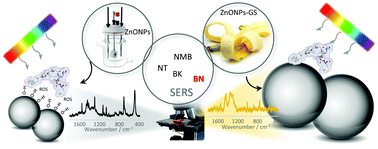SERS activity and spectroscopic properties of Zn and ZnO nanostructures obtained by electrochemical and green chemistry methods for applications in biology and medicine†
Abstract
This work for the first time evaluates the ability of homogeneous, stable, and pure zinc oxide nanoparticles (ZnONPs-GS) synthesized by “green chemistry” – an environmentally friendly, cheap, and easy method that allows efficient use of plant waste, such as banana peels, for the selective detection of four neurotransmitters present in body fluids and promotion of the SERS effect. Selective adsorption on ZnONPs-GS was compared with adsorption on the surface of (1) ZnONPs, which were obtained by electrochemical dissolution of zinc in a solution free of surfactants and (2) mechanically polished surface of bare Zn. The study showed that SERS spectroscopy using unique marker bands allows distinguishing whether the adsorbate is deposited on the surface of zinc or zinc oxide. Thus, the combination of the SERS technique with an optical probe can allow an in vivo determination of the condition of galvanized implants. The use of SERS has been extended to monitor the photocatalytic properties of surface-functionalized ZnO nanoparticles. It has been shown that despite the same structure, purity, and adsorption properties, ZnONPs-GS obtained using “green chemistry” are more bio-friendly for biological material than those obtained by the electrochemical method. This is because the surface of ZnONPs-GS is free of hydroxyl groups, which can easily form reactive oxygen species when the surface is exposed to visible radiation. Thus, surface-functionalized ZnONPS-GS can protect the biological material from the damage caused by the production and attack of an excess of ROS. Also, for an exemplary neurotransmitter, structural changes when it is not-covalently bound to Zn/ZnO were compared with the structural changes of this neurotransmitter deposited on the surface of various metals (Cu, α-Ti, and α-Fe) and metal oxides (leaf-like CuO, rutile-TiO2, and γ-Fe2O3). It has been shown that adsorption only slightly depends on the type of metallic surface and the development of this surface for roughness up to 1 micron. Metal substrates were characterized before and after the neurotransmitters' adsorption. UV-Vis, Raman, and ATR-FTIR confirmed the formation of ZnO nanoparticles. XRD showed a high crystalline structure of wurtzite. TEM and DLS showed that nanoparticles are spherical, well dispersed, and have a uniform size.



 Please wait while we load your content...
Please wait while we load your content...